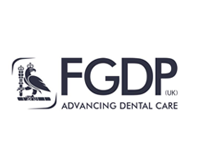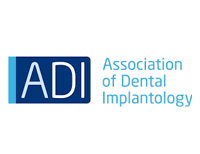Replacing all missing teeth with Dental Implants
If you are missing all of your teeth, the complexity of a full mouth reconstruction depends on the amount of jaw bone that is available. Where adequate bone is available, implants and temporary bridges can be placed on the same day.
Occasionally, it is not possible to join any remaining natural teeth to implants with a conventional bridge.
In the upper jaw, bone density is generally poorer than in the lower jaw and if you have no teeth at all, in most cases we usually prefer to place a minimum of 6 implants to support a complete arch of 10 or more replacement teeth.
In the lower jaw, the bone towards the front of the mouth is often very strong and as a direct result, fewer implants may be needed than are required to treat a whole upper jaw. A simple treatment plan to provide 10 or more teeth in the lower jaw might be possible with as few as 4 implants, although it is still more common to use 5 or 6.
It is often possible to have two or three implants placed, to use them for a while and then sometime later, to add more implants. For example a patient with no teeth can have two or more implants placed at the same time. By attaching a current denture to the implants, it can be held firmly in place. Later more implants can be added and eventually crowns placed on the implants eliminating the denture altogether.
Dental Implants
If you have lost all your teeth in one or both jaws, you can choose a permanently anchored dental implant bridge or a removable prosthesis that is connected to two or more dental implants. This is called an overdenture. This type of overdenture remains in place more firmly than a conventional removable prosthesis. For the most natural looking solution, the permanently anchored dental implant bridge is the answer when the prerequisites are met.
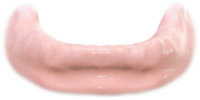
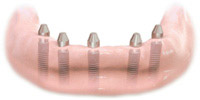
For a permanently anchored dental implant bridge, several dental implants are installed to form a good foundation. Because the dental implants are anchored in the jawbone, they stimulate the bone tissue and help to maintain healthy bone levels and facial structures.
The abutments are attached to the dental implants and the bridge is fitted in place. All dental work is performed according to your prerequisites and wishes.
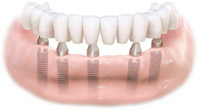

The dental implant bridge, or the overdenture, is now in place. It looks and functions like normal teeth. You can now eat whatever you like and laugh without having to worry about the prosthesis falling out.
Call our friendly reception team or ask to speak to our treatment coordinator on 0208 851 2547 for more information on arranging your Dental Implant consultation. Alternatively send us a message by clicking the button.


